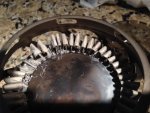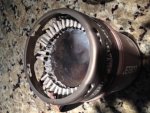So, here's the deal guys. Titanium is a metal that is called reactive, which means that they have a strong affinity for oxygen. At room temperature, titanium reacts with oxygen to from titanium dioxide. This passive, impervious coating resists further interaction with the surrounding atmosphere, and it gives titanium it's famous corrosion resistance. However, when heated, titanium becomes highly reactive and readily combines with oxygen, nitrogen, hydrogen, and carbon to form oxides (titanium's famous colors come from varying thickness of the oxide layer.) Interstitial absorption of these oxides embrittles the part and can render it useless. This typically happens above 800F. My best guess is that if the water in the cup was more directly on top of the flux ring that this wouldn't happen, rather than the large gap from the water layer to the bottom of the flux ring.



